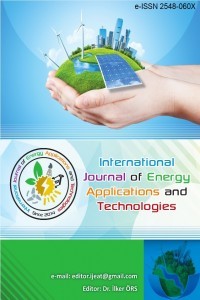Robust uncertainty modelling of energy variations in electric motors for efficient and reliable mechanical structural analysis
Robust uncertainty modelling of energy variations in electric motors for efficient and reliable mechanical structural analysis
Electric motors, energy variations, uncertainty, modelling structural analysis,
___
- [1] Farhani, F., Zaafouri, A. and Chaari, A., 2017, "Real time induction motor efficiency optimization", Journal of the Franklin Institute, 354(8): 3289-3304.[2] Verucchi, C., Ruschetti, C., Giraldo, E., Bossio, G. and Bossio, J., 2017, "Efficiency optimization in small induction motors using magnetic slot wedges", Electric Power Systems Research, 152: 1-8.[3] Hannan, M.A., Ali, J.A., Mohamed, A. and Hussain, A., 2018, "Optimization techniques to enhance the performance of induction motor drives: A review", Renewable and Sustainable Energy Reviews, 81: 1611-1626.[4] Çelik, M., Örs, İ., Bayindirli, C. and Demiralp, M., 2017, "Experimental investigation of impact of addition of bioethanol in different biodiesels, on performance, combustion and emission characteristics", Journal of Mechanical Science and Technology, 31(11): 5581-5592.[5] Kim, S.-H., "Chapter 4 - Modeling of alternating current motors and reference frame theory", in Electric Motor Control. 2017, Elsevier. p. 153-202.[6] Yu, J., Zhang, T. and Qian, J., "5 - Measurement errors and uncertainties", in Electrical Motor Products. 2011, Woodhead Publishing. p. 81-172.[7] Marino, R., Tomei, P. and Verrelli, C.M., 2008, "An adaptive tracking control from current measurements for induction motors with uncertain load torque and rotor resistance", Automatica, 44(10): 2593-2599.[8] Lu, B., Cao, W. and Habetler, T.G. "Error Analysis of Motor-Efficiency Estimation and Measurement", in 2007 IEEE Power Electronics Specialists Conference. 2007.[9] Aarniovuori, L., Kolehmainen, J., Kosonen, A., Niemelä, M. and Pyrhönen, J. "Uncertainty in motor efficiency measurements", in 2014 International Conference on Electrical Machines (ICEM). 2014.[10] Li, F., Zhang, Y., Li, J., Yang, X., Li, T. and Shang, W. "Application of Measurement Uncertainty for Electric Motor Efficiency Evaluation", in International Forum on Energy, Environment Science and Materials. 2015.[11] Choi, S.-K., Grandhi, R.V. and Canfield, R.A., 2007, "Reliability-based Structural Design: Springer-Verlag London.[12] Mayda, M., 2017, "An Efficient Simulation-Based Search Method for Reliability-Based Robust Design Optimization of Mechanical Components", MECHANIKA, 23(05): 696-702.[13] Mayda, M. and Choi, S.-K., 2017, "A reliability-based design framework for early stages of design process", Journal of the Brazilian Society of Mechanical Sciences and Engineering, 39(6): 2105-2120.
- Yayın Aralığı: Yılda 2 Sayı
- Başlangıç: 2014
- Yayıncı: İlker ÖRS
Solar star projects SAM version 2017.9.5 PVwats version 5 model case study & validation
Investigation of effects of spark plug gap on vibration, noise and HC emission in a gasoline engine
Nurullah GÜLTEKİN, Murat MAYDA
Proposal of an analog voltmeter PCB’s design layout based on DFMEA methodology for failure reduction
